How to visit the ancient city of Hattusa independently using public transport
We were travelling through the holiday hotspots of Turkey’s Black Sea but were in the mood for something a bit more cultural. Our initial plan was to stick to the coast, travelling overland from Batumi in Georgia to Istanbul, but the coastal region of Turkey was not as engaging as we had hoped (aka a bit boring). We had an inkling this would be the case but as usual, our FOMO overruled.
A quick scan of the map showed that if we altered our route slightly we could squeeze in another three UNESCO World Heritage Sites before arriving in Istanbul. One of these was the ancient Hittite Kingdom of Hattusa (sometimes spelt Hattusha). We’re not massive UNESCO-site tickers, but if we’re close to one, we’ll make the effort to get there.
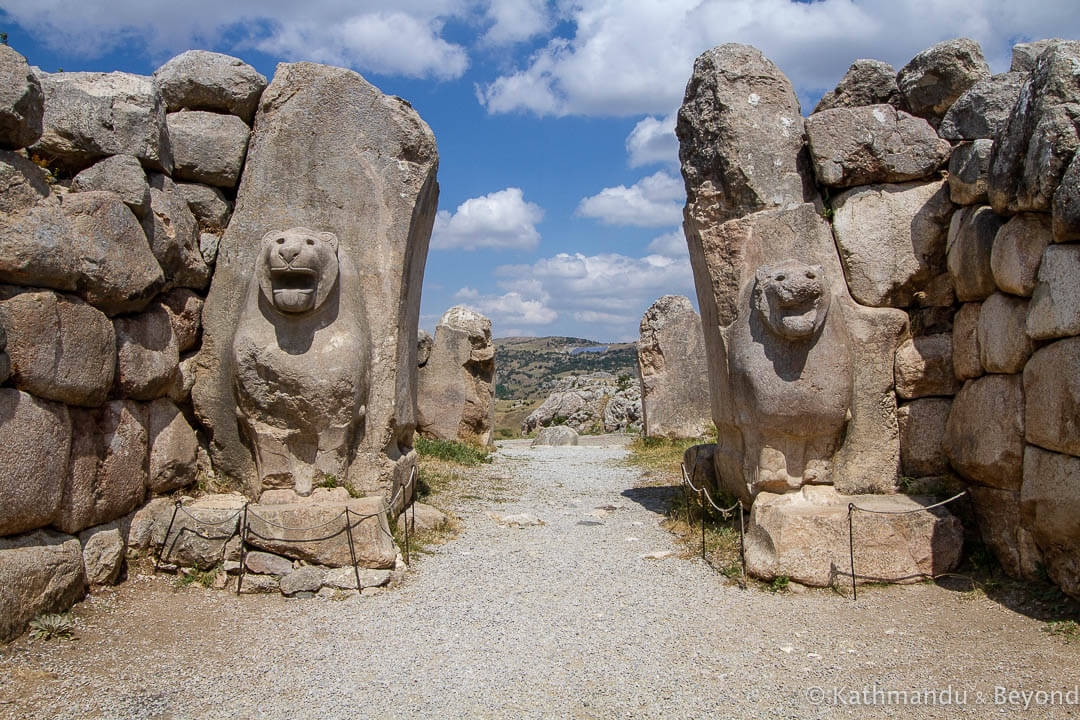
Lion Gate, Hattusa
We took the bus south and inland from Samsun on the coast, to the small town of Amasya. We visited Amasya twenty years ago, on one of our first trips together, and thought it would be a good place to return to, as we’d enjoyed our time there, and spend a few days relaxing. Some of our fondest memories of that early trip to Amasya are getting drunk with the clientele of a small bar and receiving a constant flow of fruit and other snacks to our table, courtesy of the elderly patrons. Interestingly, having a few drinks in Amasya is a lot harder today than it was two decades ago, and it made us realise that Turkey has become a lot more orthodox in recent years. It’s something we noticed all over the country, not just in the small provincial town of Amasya. We couldn’t even find a bar or restaurant that served alcohol to watch England’s World Cup match against Croatia.
Despite that, we found the people of Amasya were still very hospitable, even though it meant drinking lots of Turkish tea instead of beer. We enjoyed Amasya the second time around, and stayed a little longer than planned before continuing towards Hattusa.
Back to Hattusa, but first, a little history…
Quiz time! What do you know about the Hittite Kingdom? I’ll confess that I didn’t know much at all until we visited the site of Hattusa in Turkey’s central Anatolian region.
The Hittite Empire was significant. The Hittites are considered to be the first Indo-European civilisation; one that stretched from Syria all the way across Turkey. During the 2nd millennium BC, they were one of the most dominant powers in the region.
In 1986, ’Hattusha: the Hittite Capital’ was listed by UNESCO as a World Heritage Site under the inscription: “The archaeological site of Hattusha, former capital of the Hittite Empire, is notable for its urban organisation, the types of construction that have been preserved (temples, royal residences, fortifications), the rich ornamentation of the Lion Gate and the Royal Gate, and the ensemble of rock art at Yazilikaya. The city enjoyed considerable influence in Anatolia and northern Syria in the 2nd millennium B.C.” Source: UNESCO.
Although the site is usually referred to as Hattusa, the nearby rock-cut caves of Yazılıkaya are part of the same Hittite complex and are jointly listed by UNESCO. Hattusa was once the capital of the Hittite Kingdom (hence its importance) and Yazılıkaya was a religious sanctuary.
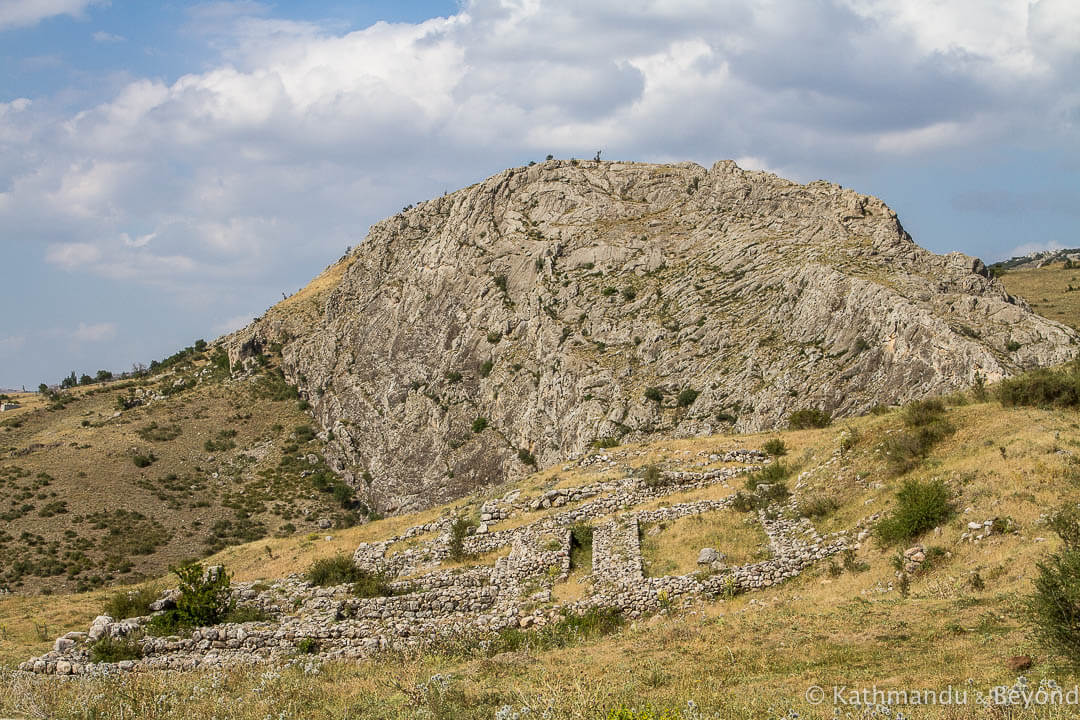
Former house, Hattusa
The logistics of getting to Hattusa
The closest town to the historical site of Hattusa is Bogazkale, some 200 kilometres east of Ankara. Amasya, the closest tourist attraction of note, is 180 kilometres in the opposite northeasterly direction. The journey from Amasya to Bogazkale looks straightforward on a map but, unless you have your own transport, it isn’t.
Travelling around Turkey using public transport is usually straightforward and we are used to turning up at a bus station and easily finding a bus or a dolmus (fixed-route minivan) to our next destination. Sometimes a change is required, but we normally arrive at our destination without too much hassle. There are exceptions but these are typically confined to out-of-the-way places or less-visited sites. We hadn’t considered Hattusa would fall into that last category, but it did.
We ended up taking a bus most of the way and hitching the rest. After getting off the bus, we were contemplating the best place to stand and wait for onward transport to Hattusa when a car pulled up and offered us a lift. This isn’t the first time this has happened and it’s how we accidentally started hitching a few years ago. The elderly man and his two equally elderly female companions didn’t speak any English but that didn’t stop them from trying to have a conversation for the entire 25-minute drive to Bogazkale. I’d earmarked a place to stay(*) and they very kindly dropped us off in front of the hotel; the guy even came in and located the owner for us.
(*) Away from Istanbul and the major cities there’s usually no need to pre-book accommodation in Turkey these days. Sadly, the country’s popularity as a tourist destination is on the decline and during our two-month trip across the country a few years ago and on this one, we did things the old-fashioned way and simply rocked up to a property we had in mind. Many hotels and guest-houses we stayed in were running on a very low occupancy. It’s a real pity as Turkey is a world-class destination with some fantastic sights. The only positive is that you often or not have the sites completely to yourself.
See further down the post for full details on the public transport and the options for getting to Hattusa independently.
Our visit to Hattusa
There is quite a bit of walking involved so we decided to visit Hattusa in the afternoon of our arrival and save Yazılıkaya until the following morning, thus splitting our sightseeing into two half-day excursions.
Our hotel was centrally located and only a short walk from the historical site. At the ticket booth, we paid the 8 lira entrance fee (a mere £1 or US$1.30 at today’s exchange rate) which covered both Hattusa and Yazılıkaya. An annoying guy on a quad bike persisted in offering us transport around the site but we declined and set off up the steep hill. We were surprised to find that you can drive your own car around the site, which everyone except us was doing!
The walk around the site is about 6km in total. It’s a circular route with a nasty uphill climb one way and a nice, downhill stroll the other. We were lucky in that someone stopped and offered us a lift up the steepest part of the track (from the Great Temple to the Lion Gate). We suggest allowing about three hours for a visit if walking. You could probably hire a taxi from Bogazkale to drive you around the site. We were also offered transport at the entrance kiosk. Make sure you carry enough water, especially on a hot day, because there’s nowhere to get a drink around the site.
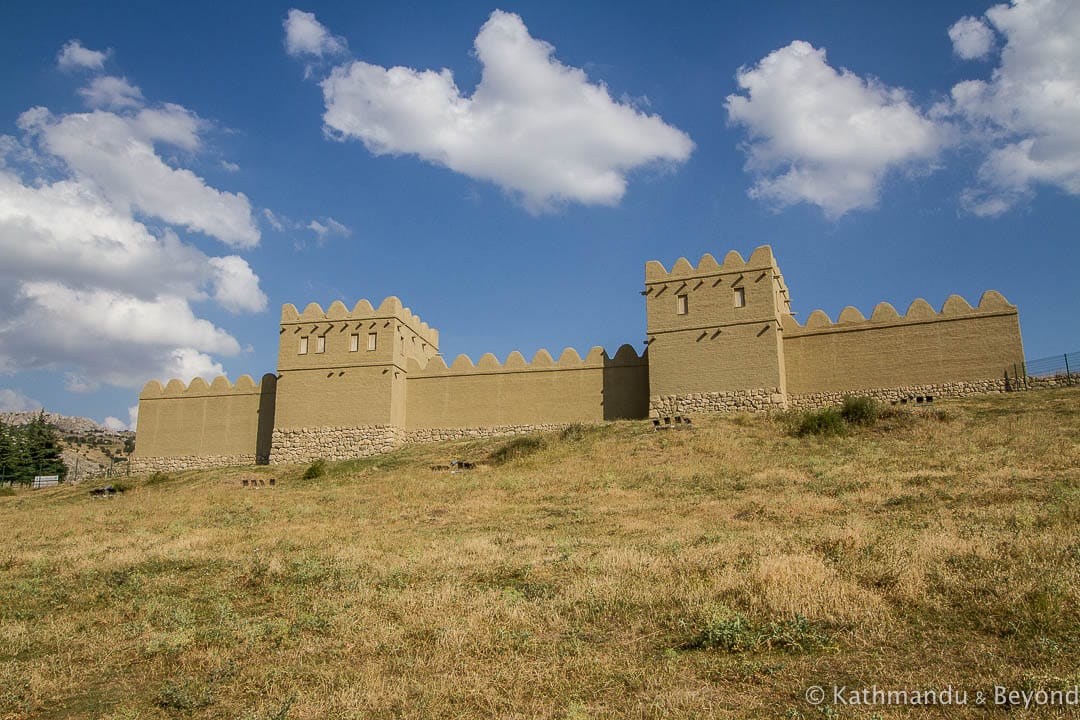
The reconstructed City Walls are the first thing you’ll see as you enter Hattusa
Start at the Great Temple (Büyük Mabet), a short distance from the entrance, and follow the road up and around in an anti-clockwise loop. A couple of hundred metres after the Great Temple, the road splits; if you take the right fork, you can’t go wrong. Head up to Lion Gate (Aslanlı Kapı) (the really steep bit), and round to Sphinx Gate (Sfenksli Kapı) and King’s Gate (Kral Kapı) where the track starts going downhill. You’ll pass the Southern Fortress (Güney Kale) before reaching the part of the road where the loop joins up. The road then returns back to the entrance passing the Great Temple again.
Much of the site has been restored or reconstructed, especially the figures on the gates, the originals of which are mostly in museums in Bogazkale and Ankara.
We enjoyed our visit to Hattusa but it’s not in the same league as other archaeological sites in Turkey like Ani, Pergamon, or Ephesus for example. On the plus side, we did have the place almost to ourselves. We visited in the late afternoon (it’s open until 7 pm in the summer) and there were only a handful of other people there. However the following morning, we saw at least five coaches full of tourists arriving on the road from Sungurlu, so our advice would be to visit in the afternoon to avoid the crowds. The light for photography is also better in the afternoon.
Visiting Yazılıkaya
If you are combining the two sites in one visit, it is possible to take a shortcut from Hattusa to Yazılıkaya, cutting out the need to go via Bogazkale. We split our sightseeing over two days but had we realised how little time is needed at Yazılıkaya we would have continued there directly from Hattusa.
The rock tombs of Yazılıkaya are approximately three kilometres from Bogazkale; again, uphill. It’s a small site but it’s worth seeing even though it took us about 40 minutes to walk there, and 20 minutes to return, and we spent only 20 minutes viewing the rock carvings.
Yazılıkaya is best viewed in the morning if you want the best light for photography although there are only a few pieces to photograph so it’s not too critical. If you visit first thing, you’re likely to be done before any incoming coaches arrive.
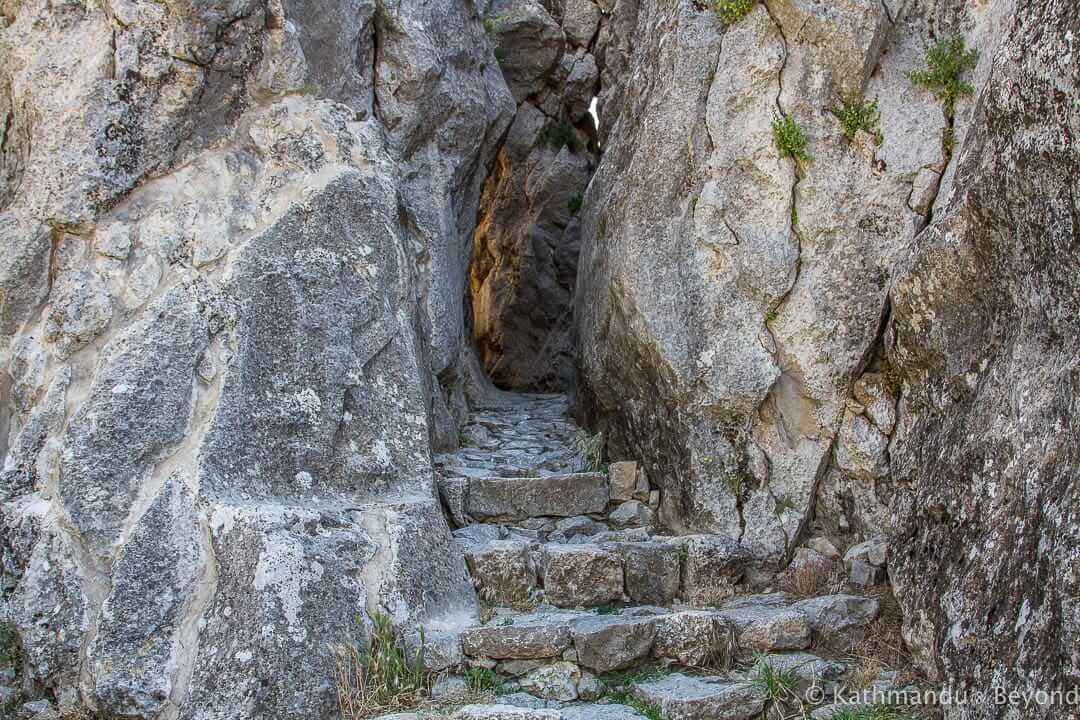
Yazılıkaya
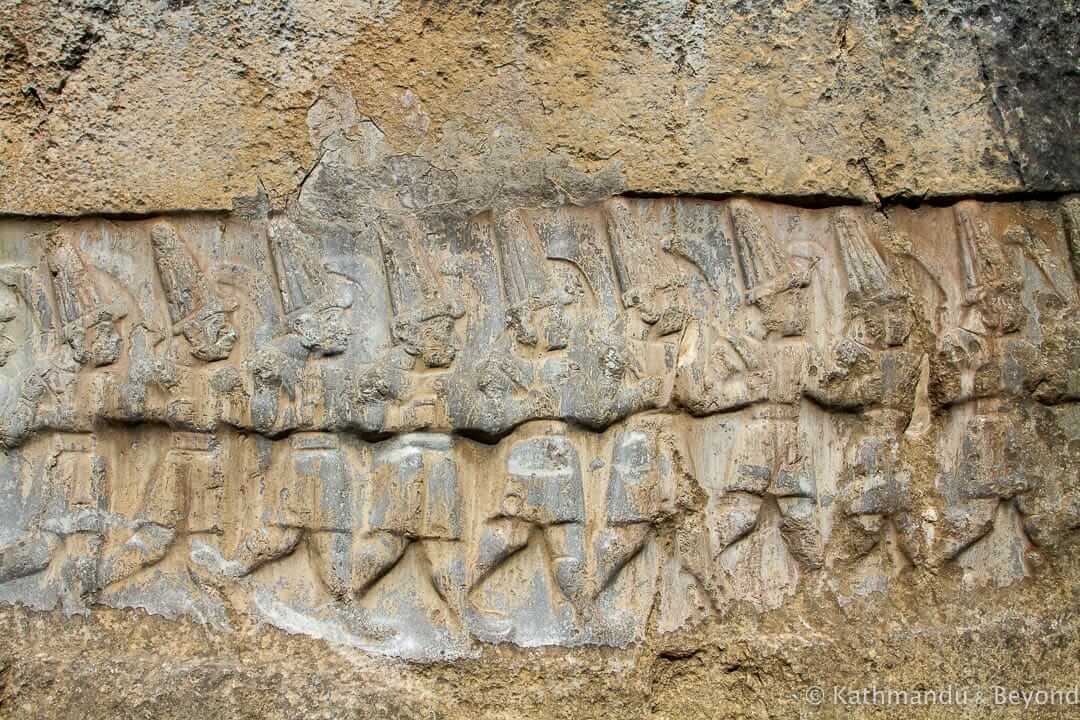
Yazılıkaya
Is it worth making the effort to visit Hattusa?
Ultimately we agreed that Hattusa was worth the effort – it’s another UNESCO site to tick off after all (except we said we didn’t do that!), but it does require a lot of imagination, especially at the Great Temple. The scenery in the area is stunning though and makes the trip worthwhile.
Map of Hattusa and the local area
Where to Stay in Bogazkale
The village of Bogazkale is the base for visiting Hattusa – it’s about 600 metres from the centre to the ticket booth. There are a few hotels, a cafe and a couple of places to eat in the village. We stayed at the Hotel Baykal which cost the equivalent of 25 Euro per night for a room with a private bathroom, including breakfast. The owner spoke good English, provided us with a free map of the site, and was helpful with our questions. The WiFi wasn’t great but we would still recommend staying there. The owner told us we were the first people to stay at his hotel for about two days and the week previously, he hadn’t had one single guest. Most people seem to visit Hattusa en route to somewhere else and don’t stay in the village. That’s a shame because Bogazkale is a small town, peaceful and typically Turkish – if our schedule had permitted, we would have stayed another day.
The Hotel Baykal was the cheapest place we found in Bogazkale as well as being both the closest to Hattusa and the most centrally located. The other options are on the road leading into the village, near the museum and the turnoff for Yazılıkaya.
Where to Eat in Bogazkale
For a proper restaurant, one of the hotels is your best option. Due to a family bereavement, the Hotel Baykal wasn’t providing dinner (they did offer to make arrangements but we didn’t want to impose on them), so we ate at the small eatery in the village. It was one of those places with a couple of pots bubbling on the stove, homestyle. The food is usually really cheap in this kind of place, but this turned out to be one of the most expensive meals on our trip! There is also a bakery which does delicious fresh pide (Turkish pizza), but only until early afternoon so it’s a lunch option, not dinner. Finally, there’s a small cafe in the square where we enjoyed several cups of tea.
How to get Bogazkale and Hattusa by public transport
This post is a resource for independent travellers but, because of the lack of public transport, Hattusa is one of those places that is far easier to visit with your own transport. This would also mean you could avoid long, hot walks to, from, and around the sites.
A taxi between Sungurlu and Bozgale should cost 60 to 70 Turkish lira although you may have to bargain hard. Alternatively, you could hire a car and see a bit more of Central Anatolia. Ankara would be a good place to rent a car (if you can cope with navigating yourself out of the city).
If, like us, you prefer to do things the hard way, here’s the nitty-gritty.
Our journey from Amasya to Hattusa and away again
Having established that no public transport goes from Amasya directly to Bogazkale, we were faced with two options:
- Take a bus to Sungurlu (approximately half way between Amasya and Ankara) and catch another bus or dolmus from there to Bogazkale. OR…
- Take an Ankara-bound bus and ask the driver to stop and drop us off on the highway close to the junction for Bogazkale.
Research, both on and offline, didn’t provide any clear information about bus schedules, so we decided on the second option. The rationale behind that decision was we’d easily be able to pick up a passing Bogazkale-bound bus and we’d be in a better position to hitch a ride if the bus didn’t appear.
The only inconvenience was that the bus stopped on the opposite side of a major highway that we needed to cross to reach the Bogazkale junction. Dashing across the road and climbing over the central reservation didn’t seem like our best plan, so we walked around the flyover. Luckily the road wasn’t busy.
Getting away from Bogazkale wasn’t as easy. By this point, we’d found out that the twice-per-day scheduled dolmus between Bogazkale and Sungurlu didn’t run on weekends. Grrrr! Being Saturday, we had no option but to hitch out. Knowing how easy it had been the previous day, we weren’t concerned, but it took us almost 45 minutes to get a ride. However, when we finally did, the guy took us all the way to Sungurlu otogar (bus station) which was kind of him. Although it wasn’t actually that long to wait, we reckon getting a lift would have been easier later in the day as we noticed significantly more traffic going towards Hattusa while waiting to go in the opposite direction
Bus schedule from Sungurlu to Bogazkale
Scheduled dolmuses are limited to twice a day during the week in each direction: from Sungurlu to Bogazkale at 7.30am and 5pm and from Bogazkale to Sungurlu at 7.30am and 5.30pm. Dolmuses may also operate at other times of the day (again not on weekends or public holidays!) but the schedule isn’t fixed and you have to wait for them to fill with passengers. If they do go, it’s usually around 9.30-10.30am. The owner of the Hotel Baykal told us there used to be much better transport options but, over time, they have become less and less. It must make it hard for small family-run guesthouses and hotels to make any money when your average backpacker or independent traveller can’t get there.
Rather than going to Sungurlu, it’s better to ask your bus driver to drop you off at the junction (GPS 40.177528, 34.461200) for Bogazkale, which is about 8km from Sungurlu, and hitch the last 22km to Hattusa. Hitching is very easy in rural areas of Turkey. We’ve done it quite a lot and have never been asked for money, even though sometimes we offer it (this has also been refused). As mentioned above, on this particular journey, on the way to Bogazkale we were picked up almost instantly and on the return it took us around 45 minutes to get a lift but this is certainly less hanging around than if we had waited for public transport.
From Sungurlu otogar there are regular buses to Ankara and other destinations in Turkey.
INSPIRED TO VISIT HATTUA? PLEASE PIN THIS POST…
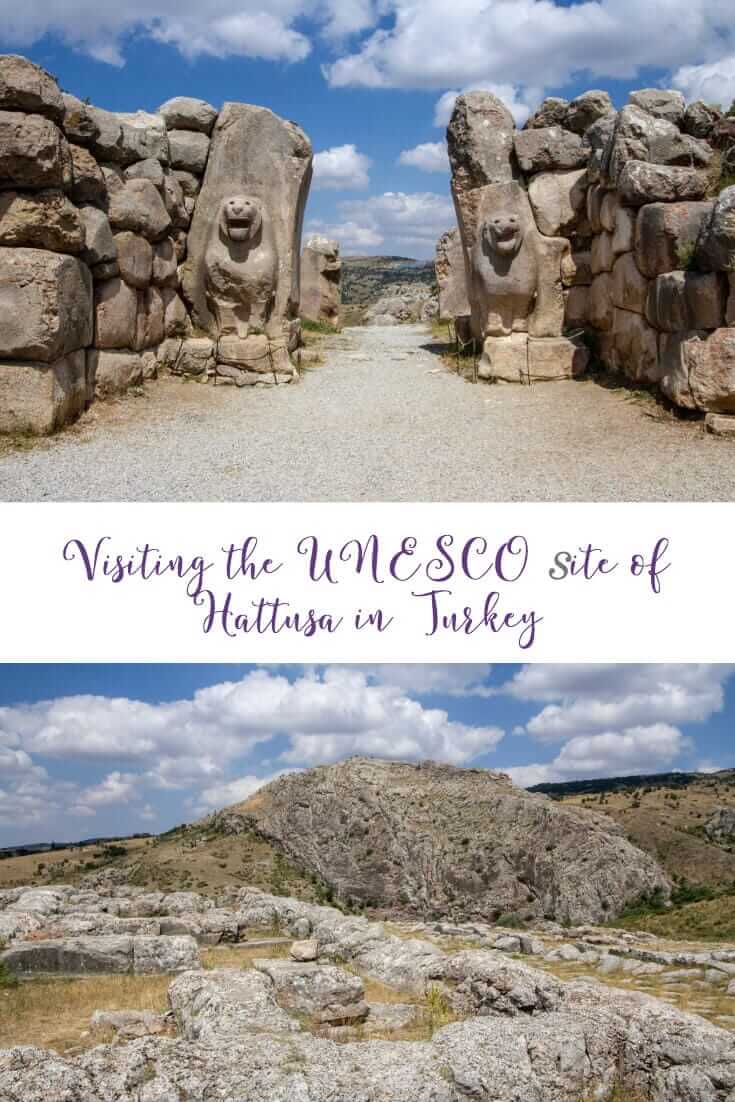
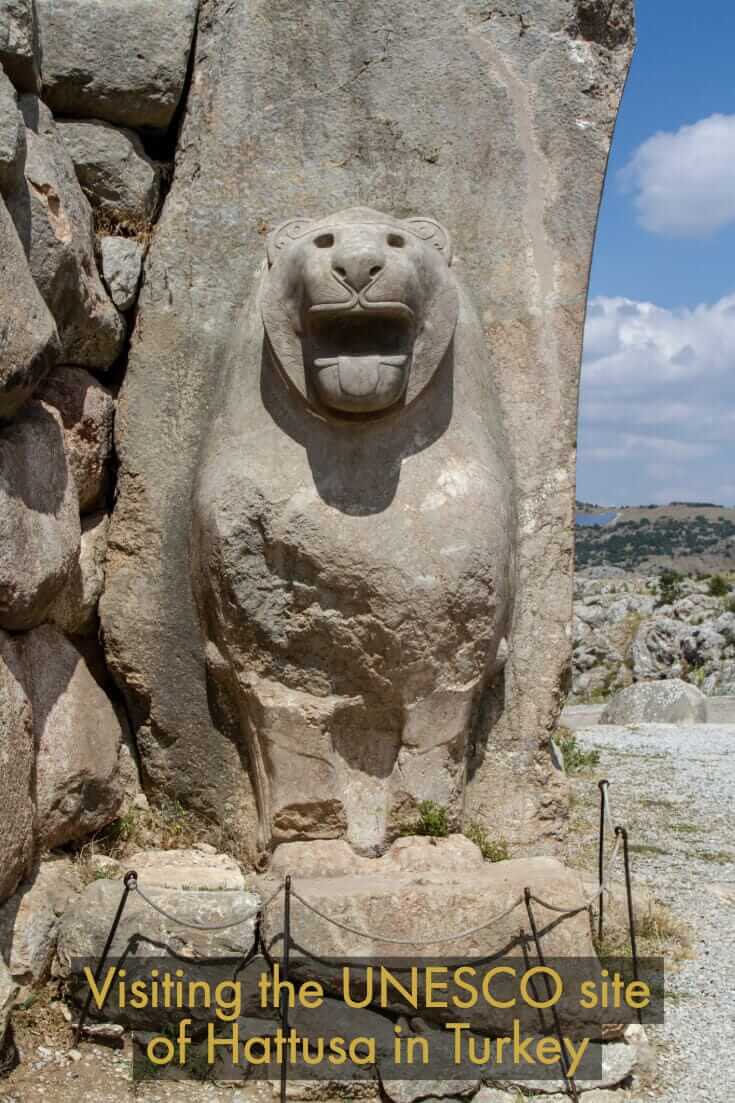
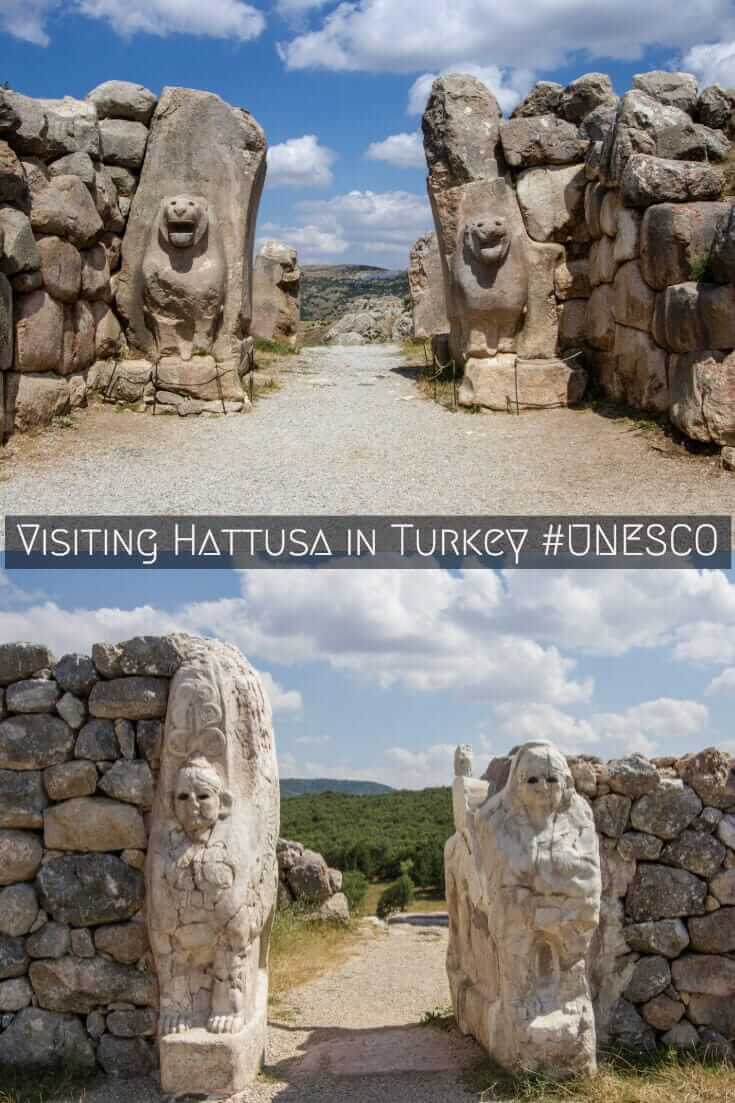

Good to know Kirsty. We are heading to Cappadocia in a week and a half and may travel around Turkey a bit. I love the country.
Turkey is a hugely underrated destination – so diverse with amazing people. It’s certainly a destination that keeps pulling us back! Enjoy your visit and I hope it’s not too chilly at this time of year after all those tropical climates you’re used to!. 😉
Hello, I am oguzhan from Ankara, Turkey. If you decide to come Turkey, Hattusa or Cappadocia, please mail to me. I can drive you and make plans for you.
[email protected]
Im thinking of travelling from Goreme/Cappadocia, up to Hattusa, I future hiring a car for the whole area is best, from what I hear from wait times, and transit issues. Anything between or near there you’d recommend?
Hello! Excuse my question: Near Hattusa, in Yazilikaya, is it possible to find the Midas Monument with an inscription?
I will appreciate your information!
Hi, I tried to stay at Hotel Baykal but would not recommend for single female travellers. I was the only one there and the owner made some creepy comments so I left.
Oh, that is disappointing, and I am sorry you had this experience. Did you find another decent place to stay? If so, I can update the post with advice on places for solo female travellers.